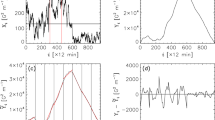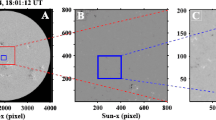Abstract
The effect of using two representations of the normal-to-surface magnetic field to calculate photospheric measures that are related to the active region (AR) potential for flaring is presented. Several AR properties were computed using line-of-sight (\(B_{\mathrm{los}}\)) and spherical-radial (\(B_{r}\)) magnetograms from the Space-weather HMI Active Region Patch (SHARP) products of the Solar Dynamics Observatory, characterizing the presence and features of magnetic polarity inversion lines, fractality, and magnetic connectivity of the AR photospheric field. The data analyzed correspond to \({\approx\,}4{,}000\) AR observations, achieved by randomly selecting 25% of days between September 2012 and May 2016 for analysis at 6-hr cadence. Results from this statistical study include: i) the \(B_{r}\) component results in a slight upwards shift of property values in a manner consistent with a field-strength underestimation by the \(B_{\mathrm{los}}\) component; ii) using the \(B_{r}\) component results in significantly lower inter-property correlation in one-third of the cases, implying more independent information as regards the state of the AR photospheric magnetic field; iii) flaring rates for each property vary between the field components in a manner consistent with the differences in property-value ranges resulting from the components; iv) flaring rates generally increase for higher values of properties, except the Fourier spectral power index that has flare rates peaking around a value of \(5/3\). These findings indicate that there may be advantages in using \(B_{r}\) rather than \(B_{\mathrm{los}}\) in calculating flare-related AR magnetic properties, especially for regions located far from central meridian.







Similar content being viewed by others
References
Abramenko, V.I.: 2005, Relationship between magnetic power spectrum and flare productivity in solar active regions. Astrophys. J. 629, 1141. DOI . ADS .
Ahmed, O., Qahwaji, R., Colak, T., Dudok De Wit, T., Ipson, S.: 2010, A new technique for the calculation and 3D visualisation of magnetic complexities on solar satellite images. Vis. Comput. 26, 385. DOI .
Al-Ghraibah, A., Boucheron, L.E., McAteer, R.T.J.: 2015, An automated classification approach to ranking photospheric proxies of magnetic energy build-up. Astron. Astrophys. 579, A64. DOI . ADS .
Alissandrakis, C.E.: 1981, On the computation of constant alpha force-free magnetic field. Astron. Astrophys. 100, 197. ADS .
Aschwanden, M.J., Caspi, A., Cohen, C.M.S., Holman, G., Jing, J., Kretzschmar, M., Kontar, E.P., McTiernan, J.M., Mewaldt, R.A., O’Flannagain, A., Richardson, I.G., Ryan, D., Warren, H.P., Xu, Y.: 2017, Global energetics of solar flares. V. Energy closure in flares and coronal mass ejections. Astrophys. J. 836, 17. DOI . ADS .
Barnes, G., Leka, K.D.: 2006, Photospheric magnetic field properties of flaring versus flare-quiet active regions. III. Magnetic charge topology models. Astrophys. J. 646, 1303. DOI . ADS .
Barnes, G., Leka, K.D.: 2008, Evaluating the performance of solar flare forecasting methods. Astrophys. J. Lett. 688, L107. DOI . ADS .
Barnes, G., Longcope, D.W., Leka, K.D.: 2005, Implementing a magnetic charge topology model for solar active regions. Astrophys. J. 629, 561. DOI . ADS .
Bobra, M.G., Sun, X., Hoeksema, J.T., Turmon, M., Liu, Y., Hayashi, K., Barnes, G., Leka, K.D.: 2014, The Helioseismic and Magnetic Imager (HMI) vector magnetic field pipeline: SHARPs – Space-weather HMI active region patches. Solar Phys. 289, 3549. DOI . ADS .
Bokenkamp, N.: 2007, Statistical relationships between solar active region photospheric magnetic properties and flare events. Ph.D. thesis, Stanford University.
Conlon, P.A., Gallagher, P.T., McAteer, R.T.J., Ireland, J., Young, C.A., Kestener, P., Hewett, R.J., Maguire, K.: 2008, Multifractal properties of evolving active regions. Solar Phys. 248, 297. DOI . ADS .
Conlon, P.A., McAteer, R.T.J., Gallagher, P.T., Fennell, L.: 2010, Quantifying the evolving magnetic structure of active regions. Astrophys. J. 722, 577. DOI . ADS .
Domingo, V., Fleck, B., Poland, A.I.: 1995, The SOHO mission: An overview. Solar Phys. 162, 1. DOI . ADS .
Ermolli, I., Giorgi, F., Romano, P., Zuccarello, F., Criscuoli, S., Stangalini, M.: 2014, Fractal and multifractal properties of active regions as flare precursors: A case study based on SOHO/MDI and SDO/HMI observations. Solar Phys. 289, 2525. DOI . ADS .
Falconer, D.A., Moore, R.L., Gary, G.A.: 2003, A measure from line-of-sight magnetograms for prediction of coronal mass ejections. J. Geophys. Res. 108, 1380. DOI . ADS .
Falconer, D.A., Moore, R.L., Barghouty, A.F., Khazanov, I.: 2012, Prior flaring as a complement to free magnetic energy for forecasting solar eruptions. Astrophys. J. 757, 32. DOI . ADS .
Falconer, D.A., Tiwari, S.K., Moore, R.L., Khazanov, I.: 2016, A new method to quantify and reduce the net projection error in whole-solar-active-region parameters measured from vector magnetograms. Astrophys. J. Lett. 833, L31. DOI . ADS .
Fan, Y., Gibson, S.E.: 2007, Onset of coronal mass ejections due to loss of confinement of coronal flux ropes. Astrophys. J. 668, 1232. DOI . ADS .
Georgoulis, M.K.: 2010, Pre-eruption magnetic configurations in the active-region solar photosphere. Proc. Int. Astron. Union 6(S273), 495. DOI .
Georgoulis, M.: 2013, Toward an efficient prediction of solar flares: Which parameters, and how? Entropy 15(11), 5022. DOI .
Georgoulis, M.K., Rust, D.M.: 2007, Quantitative forecasting of major solar flares. Astrophys. J. Lett. 661, L109. DOI . ADS .
Guerra, J.A., Pulkkinen, A., Uritsky, V.M., Yashiro, S.: 2015, Spatio-temporal scaling of turbulent photospheric line-of-sight magnetic field in active region NOAA 11158. Solar Phys. 290, 335. DOI . ADS .
Hewett, R.J., Gallagher, P.T., McAteer, R.T.J., Young, C.A., Ireland, J., Conlon, P.A., Maguire, K.: 2008, Multiscale analysis of active region evolution. Solar Phys. 248, 311. DOI . ADS .
Hoeksema, J.T., Liu, Y., Hayashi, K., Sun, X., Schou, J., Couvidat, S., Norton, A., Bobra, M., Centeno, R., Leka, K.D., Barnes, G., Turmon, M.: 2014, The Helioseismic and Magnetic Imager (HMI) vector magnetic field pipeline: Overview and performance. Solar Phys. 289, 3483. DOI . ADS .
Kliem, B., Török, T.: 2006, Torus instability. Phys. Rev. Lett. 96(25), 255002. DOI . ADS .
Kolmogorov, A.: 1941, The local structure of turbulence in incompressible viscous fluid for very large Reynolds’ numbers. Dokl. Akad. Nauk SSSR 30, 301. ADS .
Leka, K.D., Barnes, G.: 2007, Photospheric magnetic field properties of flaring versus flare-quiet active regions. IV. A statistically significant sample. Astrophys. J. 656, 1173. DOI . ADS .
Leka, K.D., Barnes, G., Wagner, E.L.: 2017, Evaluating (and improving) estimates of the solar radial magnetic field component from line-of-sight magnetograms. Solar Phys. 292, 36. DOI . ADS .
Liu, Y.: 2008a, A study of surges: II. On the relationship between chromospheric surges and coronal mass ejections. Solar Phys. 249, 75. DOI . ADS .
Liu, Y.: 2008b, Magnetic field overlying solar eruption regions and kink and torus instabilities. Astrophys. J. Lett. 679, L151. DOI . ADS .
Mason, J.P., Hoeksema, J.T.: 2010, Testing automated solar flare forecasting with 13 years of Michelson Doppler imager magnetograms. Astrophys. J. 723, 634. DOI . ADS .
McAteer, R.T.J., Gallagher, P.T., Ireland, J.: 2005, Statistics of active region complexity: A large-scale fractal dimension survey. Astrophys. J. 631, 628. DOI . ADS .
Pesnell, W.D., Thompson, B.J., Chamberlin, P.C.: 2012, The Solar Dynamics Observatory (SDO). Solar Phys. 275, 3. DOI . ADS .
Scherrer, P.H., Bogart, R.S., Bush, R.I., Hoeksema, J.T., Kosovichev, A.G., Schou, J., et al.: 1995, The solar oscillations investigation – Michelson Doppler imager. Solar Phys. 162, 129. DOI . ADS .
Scherrer, P.H., Schou, J., Bush, R.I., Kosovichev, A.G., Bogart, R.S., Hoeksema, J.T., et al.: 2012, The helioseismic and magnetic imager (hmi) investigation for the solar dynamics observatory (sdo). Solar Phys. 275, 207. DOI .
Schrijver, C.J.: 2007, A characteristic magnetic field pattern associated with all major solar flares and its use in flare forecasting. Astrophys. J. Lett. 655, L117. DOI . ADS .
Thompson, W.T.: 2006, Coordinate systems for solar image data. Astron. Astrophys. 449, 791. DOI . ADS .
Török, T., Kliem, B.: 2005, Confined and ejective eruptions of kink-unstable flux ropes. Astrophys. J. Lett. 630, L97. DOI . ADS .
Zuccarello, F.P., Aulanier, G., Gilchrist, S.A.: 2015, Critical decay index at the onset of solar eruptions. Astrophys. J. 814, 126. DOI . ADS .
Zuccarello, F.P., Seaton, D.B., Mierla, M., Poedts, S., Rachmeler, L.A., Romano, P., Zuccarello, F.: 2014, Observational evidence of torus instability as trigger mechanism for coronal mass ejections: The 2011 August 4 filament eruption. Astrophys. J. 785, 88. DOI . ADS .
Acknowledgements
This research was funded by the European Union Horizon 2020 research and innovation programme under grant agreement No. 640216 (FLARECAST). SHARP data were provided by courtesy of NASA/SDO and the HMI science team, and hosted for FLARECAST ( http://flarecast.eu ) by the MEDOC data and operations centre ( http://medoc.ias.u-psud.fr ; CNES/CNRS/Univ. Paris-Sud). We thank the anonymous referees for their comments; they certainly helped improve the manuscript.
Author information
Authors and Affiliations
Corresponding author
Ethics declarations
Disclosure of Potential Conflicts of Interest
The authors declare that they have no conflicts of interest.
Appendix: Correlation Coefficients
Appendix: Correlation Coefficients
Tables 2 and 3 each contain values of linear (Pearson) and nonlinear-rank (Spearman) correlation coefficients (CC) for all AR property-pair combinations for \(B_{\mathrm{los}}\) and \(B_{r}\), respectively. The coefficients are calculated separately for the three groups of SHARP longitudes with data points colour-coded in Figures 6 and 7: \(|\phi| < 60^{\circ}\) (black); \(60 \leqslant|\phi| < 75^{\circ}\) (blue); \(|\phi| \geqslant 75^{\circ}\) (red). Figure 8 presents the errors for correlation coefficients contained in Tables 2 and 3. In both panels, plots of standard error versus CC value for linear (filled circles) and nonlinear (open circles) correlations in all three longitudinal-position groups (same colour code applies). The left panel corresponds to \(B_{\mathrm{los}}\)-calculated properties and the right panel corresponds to \(B_{r}\)-calculated properties. The standard error for a (linear/nonlinear) correlation coefficient is estimated as
where \(r\) can be the Pearson or the Spearman CC, and \(n\) is the number of points used in their calculations. The dotted lines in the plots of Figure 8 mark ranges for expressing the standard errors in percentage of the CC value.
Rights and permissions
About this article
Cite this article
Guerra, J.A., Park, SH., Gallagher, P.T. et al. Active Region Photospheric Magnetic Properties Derived from Line-of-Sight and Radial Fields. Sol Phys 293, 9 (2018). https://doi.org/10.1007/s11207-017-1231-z
Received:
Accepted:
Published:
DOI: https://doi.org/10.1007/s11207-017-1231-z





